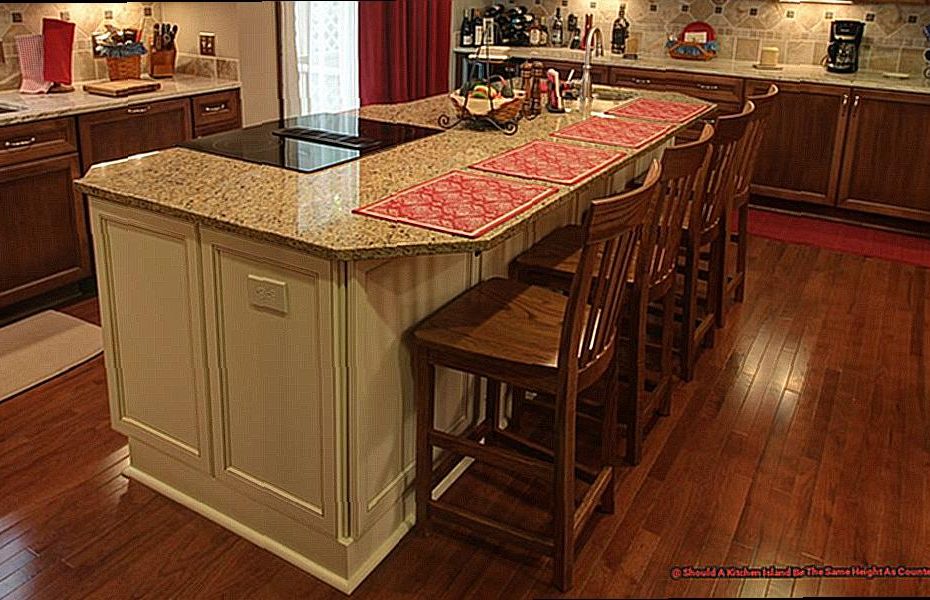Imagine this: You’re finally ready to give your kitchen a much-needed makeover and you can’t wait to add a sleek and functional island. But before you get too excited, have you thought about the height of your island in relation to your counter? It may seem like a small detail, but trust me, it’s not just about aesthetics – there are practical reasons why matching these two heights is crucial. So let’s dive in and discover why getting the ideal height for your kitchen island is essential.
First off, having a mismatched height between your island and counter can lead to discomfort and strain on your back while prepping meals or enjoying a quick bite at the island. And let’s be real, no one wants to deal with back pain in the kitchen. Not only that, but it also affects the flow and functionality of your space, making it difficult to move around freely. But fear not, because there’s more to this than just avoiding physical discomfort.
Having a properly matched height between your kitchen island and counter creates a cohesive look that adds value to your home. Think about it – when everything is perfectly aligned and balanced, it gives off a sense of harmony and elegance that can elevate the overall aesthetic of your kitchen. Plus, it shows attention to detail and adds an extra touch of sophistication.
Now that we’ve established why matching these two heights is important, let’s talk about how you can achieve the perfect balance. From considering the standard measurements for kitchen islands to adjusting based on personal preferences and needs, we’ll cover all the tips and tricks you need to know. So don’t worry about your kitchen island standing out for all the wrong reasons – follow our guide and make sure it fits seamlessly into your space. Let’s get started.
Contents
What Is A Standard Kitchen Island Height?
The ideal height for a kitchen island to ensure it aligns with the counter is 910mm (36 inches). This standard measurement offers both practicality and functionality in the kitchen. However, it is possible to personalize the island’s height to better suit one’s unique needs and preferences.
Points to Consider When Determining Kitchen Island Height:
- Ergonomics: The height of the kitchen island should be comfortable for food preparation and cooking. It is crucial to consider the height of the person who will be using it most often to ensure it is at an optimal working level.
- Seating: If the kitchen island will have seating, it is important to take into account the height of the stools or chairs. Counter-height seating typically ranges from 62-72cm, while bar-height seating falls between 75-85cm. The island’s height may need to be adjusted accordingly to accommodate comfortable seating.
- Design Preference: Some individuals may prefer a higher or lower island for aesthetic purposes. It is possible to adjust the island’s height to match the counters or make it stand out as a statement piece in the kitchen.
- Functionality: An all-bar-height island may not be practical for everyday use, as it may be too tall for food preparation or dining. It is recommended to have a combination of counter and bar heights for a more functional kitchen island.
Although the standard height for a kitchen island is 910mm (36 inches), this can vary depending on personal needs and preferences. It is essential to take into account ergonomics, seating, design preference, and functionality when determining the island’s height.
Should A Kitchen Island Be The Same Height As Your Countertop?
The ideal height for a kitchen island is typically the same as the countertop, which is commonly set at 36 inches (910mm). However, this may vary depending on personal preferences and needs. Factors such as comfort, seating, design, and functionality should all be taken into account when determining the appropriate height for a kitchen island. This includes considering the overall height of the person using the island and their preferred working and seating positions.
Moreover, it is important to also consider the purpose of the island. If it will mainly be used for food preparation and cooking, it is best to keep it at the standard countertop height. However, if it will also serve as a dining area or workspace, raising it to 42 inches (1065mm) can provide a more comfortable seating or working position.
In addition to considering ergonomics and functionality, the overall design of the kitchen should also be taken into consideration when determining the height of the island. It should be proportionate to the size of the kitchen and other elements such as cabinets and appliances.
When planning for a kitchen island, it is crucial to leave enough space around it for ease of movement and functionality. The recommended minimum distance from any point of the island to a cabinet, wall, or appliance is 42 inches (1065mm). This allows ample room to move around comfortably while using the island.
In summary, while the standard height for a kitchen island is typically 36 inches (910mm), it can be adjusted to fit individual preferences and needs based on factors such as comfort, seating, design, and functionality.
What’s The Difference Between Counter Height And Bar Height?
Counter height and bar height are two commonly used measurements for seating and countertops in both residential and commercial spaces. The primary distinction between these two measurements is the distance from the floor, with counter height being lower than bar height.
Standard Measurements:
- Counter height seating measures 24-26 inches from the floor to the seat, while bar height seating measures 28-30 inches.
- Counter-height countertops sit 36 inches above the floor, while bar-height countertops are 40-42 inches from the floor.
Differences:
Functionality:
Counter-height seating is typically utilized for kitchen islands and standard-height counters, providing a practical and comfortable seating option for everyday use. In contrast, bar-height seating is better suited for taller surfaces like pub tables and bars, where individuals may prefer to sit at a higher level for a more casual and social experience.
Design:
The difference in height between counter and bar seating also impacts the overall design of a space. Counter-height seating creates a more conventional and familiar appearance, while bar-height seating adds a touch of sophistication and modernity.
Purpose:
Counter-height countertops are often used for meal preparation, making it easier to chop, cook, and clean at a comfortable standing level. On the other hand, bar-height countertops are frequently installed as an elevated ledge attached to a lower countertop, providing a space for guests to sit and socialize while still being able to see into the kitchen.
So, counter height and bar height have distinct differences in terms of functionality, design, and purpose. It is crucial to consider these factors when determining which option is best for your space.
What Height Should A Kitchen Island With A Dining Table Be?
When deciding on the ideal height for a kitchen island with a dining table, it’s important to consider both counter and bar height options. This allows for a range of seating choices and serves both dining and food prep purposes. Standard counter height seating ranges from 62-72cm while bar height seating is typically 75-85cm. For the dining table portion of the kitchen island, a recommended height of 760mm (30 inches) is suggested, although this can vary depending on personal preferences.
Using a combination of both counter and bar height also provides the opportunity for customization to meet specific needs, such as adjusting the overall height for comfort or incorporating different seating options. The thickness of the countertop and construction of the cabinets can also impact the overall height of the kitchen island.
When determining the height of a kitchen island, it’s important to consider its purpose and functionality. For instance, if it will primarily serve as a dining space, a lower overall height may be more desirable to accommodate chairs or stools. However, if it will mainly be used for food preparation, a higher overall height may be more practical.
Ultimately, there is no one set recommended height for a kitchen island with a dining table as it largely depends on individual needs and design preferences.
Conclusion
In summary, the height of your kitchen island compared to your counter is a crucial aspect when designing your ideal kitchen. As we’ve discussed, it not only affects practicality but also plays a significant role in the overall aesthetic of your space.
Ensuring that your island and counter are properly matched in height can prevent discomfort and strain on your back while cooking or dining. It also enhances the flow and functionality of your kitchen, adding value and sophistication to your home.
While the standard height for a kitchen island is 36 inches (910mm), there are several factors to consider when determining the perfect height for your needs. From ergonomics and seating options to incorporating design elements and functionality, finding the right balance is essential.
So, before embarking on your kitchen renovation journey, remember these tips to achieve a seamless look with a perfectly aligned kitchen island and counter height. Trust us, it will make all the difference in creating a beautiful and functional space that you can enjoy for years to come.





